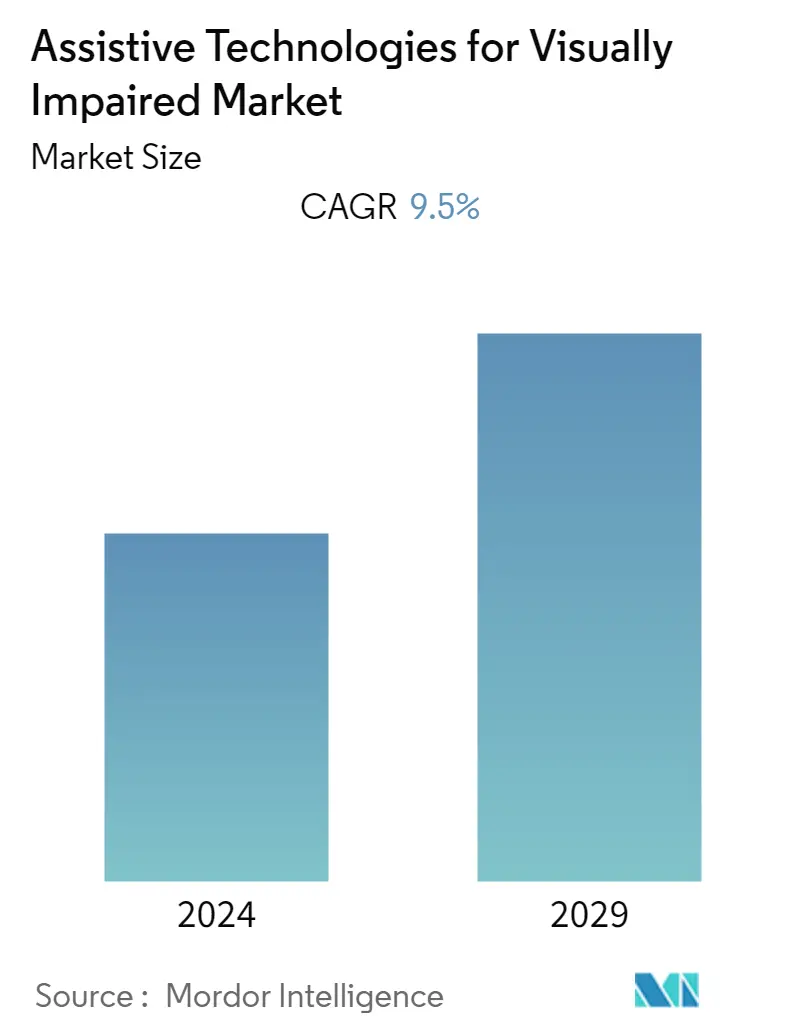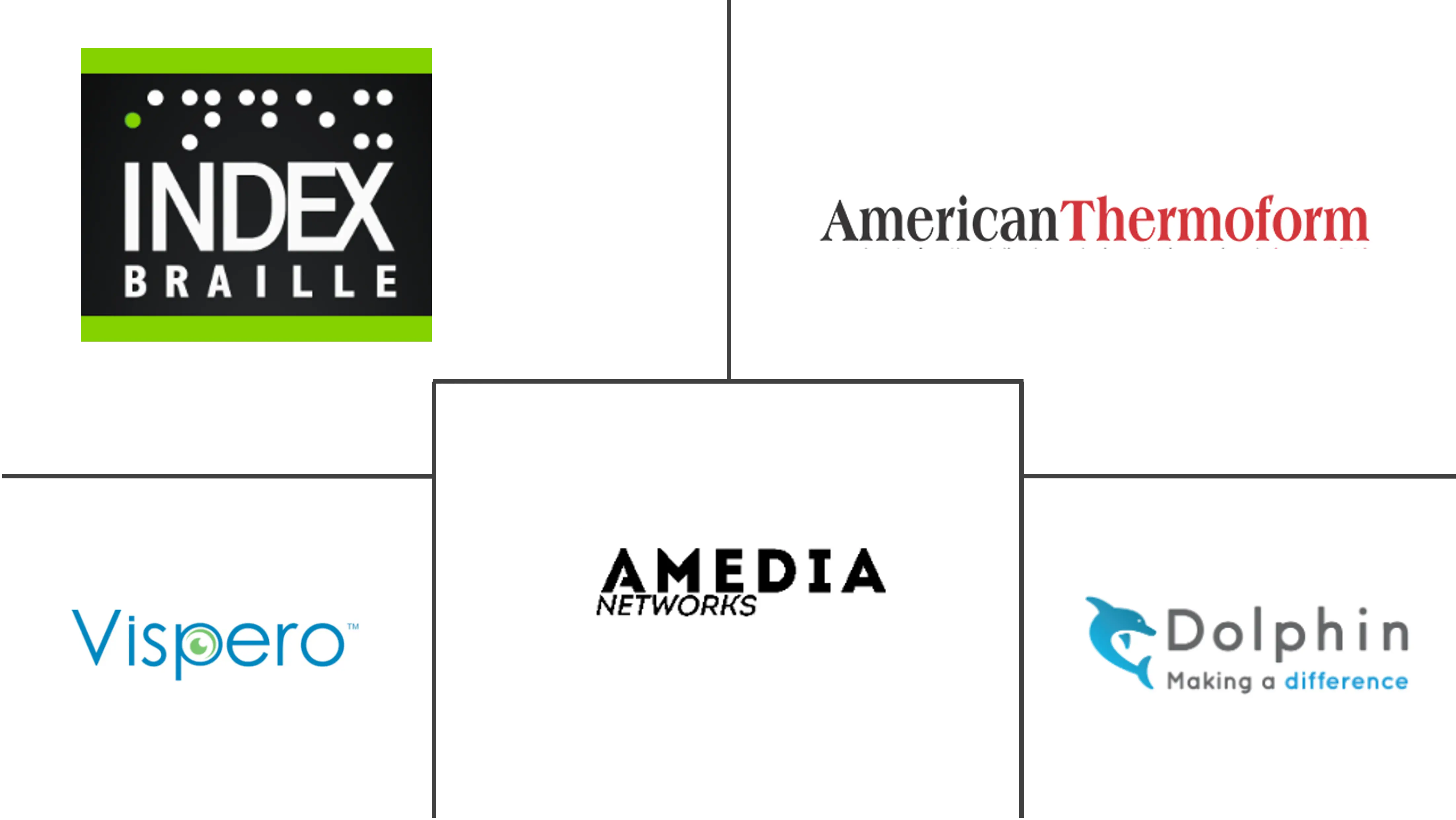Market Size of Assistive Technologies for Visually Impaired Industry

| Study Period | 2019 - 2029 |
| Base Year For Estimation | 2023 |
| CAGR | 9.50 % |
| Fastest Growing Market | Asia-Pacific |
| Largest Market | North America |
| Market Concentration | Medium |
Major Players
*Disclaimer: Major Players sorted in no particular order |
Assistive Technologies for Visually Impaired Market Analysis
The assistive technologies for the visually impaired market are expected to register a CAGR of 9.5% over the forecast period.
The COVID-19 pandemic has had a slight adverse impact on assistive technologies for the visually impaired market initially. With the outbreak of COVID-19, the market for assistive technologies for the visually impaired experienced a slight fall in growth. It was primarily due to the imposition of lockdown and the prioritization of COVID-related and only critical condition treatment. During the pandemic, the risk of COVID-19 infections reduced the number of regular visits by visually impaired patients or students to blind schools, hospitals, etc. This put a halt to their consultation and visual assistance. Although the pandemic was widespread, teleconsultation and virtual classes for visually impaired patients and students helped manage their situations and needs. The study conducted by the American Action Fund for Blind Children and Adults in 2020 and 2021 stated that blind and low-vision students across the United States and Canada shifted from their in-person education mode to the virtual education mode amid the pandemic. However, it was found that in some cases, blind or low-vision students had no access to education due to the lockdown after the COVID-19 outbreak. A study published in the journal Research in Developmental Disabilities in 2021 highlighted the use and efficacy of online interventions for visually impaired children. It was observed that the parents felt reassured by the uninterrupted online treatment of their children. In the post-pandemic era, global unlocking, the availability of vaccines, and control cases of COVID-19 allowed visually impaired patients to get back to their treatment regime and access assistance. For instance, in January 2022, the Ontario Provincial Schools for the Deaf and Blind reopened. In February 2022, the White House administration of the United States announced the guidelines for people with disabilities and older adults in response to and recovery from COVID-19. The guidelines highlighted using appropriate resources and equipment to support in-person learning for children with disabilities. Thus, the COVID-19 outbreak had a slightly adverse impact on the market's growth in its preliminary phase. Moreover, the market is expected to grow further at a stable pace with the reopening of blind schools and the regular visits of visually impaired patients to blind schools, hospitals, and clinics globally.
Further, the high prevalence of visual impairment and blindness globally is boosting the growth of the market. According to the WHO, in October 2022, there will be over 2.2 billion people worldwide living with near or distant vision impairment. In addition, the expanding geriatric population globally will propel market growth. The condition of aging is accompanied by several vision-related disorders and even loss of vision. According to the National Institute on Aging, aging is associated with dry eyes, age-related macular degeneration, diabetic retinopathy, cataracts, and glaucoma. According to a study published in JAMA Ophthalmology in 2022, over 1.49 million people aged 40 years and older are living with late-stage age-related macular degeneration. According to the WHO, people aged 60 and above were recorded at 1 billion, and the number is expected to increase to 1.4 billion in 2030. The market players have launched innovative solutions for visually impaired assistive devices. In August 2021, OrCam launched its latest software, Version 9.10, for its two products, the wearable OrCam MyEye, which is intended for blind and visually impaired individuals, and the handheld OrCam Read, intended for individuals with reading challenges. The latest software would offer an improved experience and better accessibility for the hands-free voice command functions.
Therefore, owing to the high prevalence of visual impairment and blindness and the expanding geriatric population, the studied market is anticipated to witness growth over the analysis period. However, the high cost of electronic visual assistance products is likely to impede market growth.
Assistive Technologies for Visually Impaired Industry Segmentation
As per the scope of the report, Assistive Technologies for the Visually Impaired consists of products that aid blind or visually impaired individuals to study/read, hear, and write, and also assist in mobility. The Assistive Technologies for the Visually Impaired Market is segmented by Product Type (Educational Devices & Software (Braille Computers/Systems, Braille Duplicators & Writers, Mathematical & Science Devices, Reading Machines, and Others), Mobility Devices, Low Vision Devices (Smart Glasses, Magnifying Lenses, Others), and Others), By End User (Blind Schools and Training Institutes, Government/Social/Non-profit organizations, and Enterprises, Federation & Hospital, and Personal Use), and Geography (North America, Europe, Asia-Pacific, Middle East and Africa, and South America). The market report also covers the estimated market sizes and trends for 17 different countries across major regions globally. The report offers the value (in USD million) for the above segments.
| By Product Type | |||||||
| |||||||
| Mobility Devices | |||||||
| |||||||
| Others (Document Holders, Monitors, and Desks) |
| By End User Type | |
| Blind Schools and Training Institutes | |
| Government/Social/Non-profit Organizations and Enterprises | |
| Federation & Hospital | |
| Personal Use |
| Geography | ||||||||
| ||||||||
| ||||||||
| ||||||||
| ||||||||
|
Assistive Technologies for Visually Impaired Market Size Summary
The assistive technologies for the visually impaired market is poised for significant growth, driven by the increasing prevalence of visual impairment and blindness globally, alongside an expanding geriatric population. The market experienced a temporary setback due to the COVID-19 pandemic, which initially disrupted regular consultations and educational activities for visually impaired individuals. However, the shift to teleconsultation and virtual classes mitigated some of the adverse effects, allowing for continued support and education. As the world gradually reopened and vaccination efforts took hold, the market began to recover, with visually impaired individuals resuming access to necessary treatments and educational resources. The introduction of innovative solutions, such as advanced software for wearable and handheld devices, further supports the market's expansion.
North America is expected to lead the market, bolstered by a substantial population of visually impaired individuals, a robust geriatric demographic, and advanced healthcare and educational infrastructure. The region benefits from financial assistance programs and grants that support the acquisition of assistive devices and training. The presence of key industry players and ongoing developments, such as strategic acquisitions and partnerships, are anticipated to drive further growth. The market is moderately consolidated, with several international and regional companies competing for market share. Recent product launches, including multi-line braille displays and interactive tactile graphic systems, highlight the continuous innovation within the sector, reinforcing the market's positive trajectory.
Assistive Technologies for Visually Impaired Market Size - Table of Contents
-
1. MARKET DYNAMICS
-
1.1 Market Overview
-
1.2 Market Drivers
-
1.2.1 Expanding Population Base of The Geriatric People
-
1.2.2 High Prevalence of Visual Impairment and Blindness
-
1.2.3 Technological Advancements in The Visually Assisted Products
-
-
1.3 Market Restraints
-
1.3.1 High Cost of Electronic Visual Assistance Products
-
-
1.4 Porter Five Forces
-
1.4.1 Threat of New Entrants
-
1.4.2 Bargaining Power of Buyers/Consumers
-
1.4.3 Bargaining Power of Suppliers
-
1.4.4 Threat of Substitute Products
-
1.4.5 Intensity of Competitive Rivalry
-
-
-
2. MARKET SEGMENTATION (Market Size by Value - USD million)
-
2.1 By Product Type
-
2.1.1 Educational Devices & Software
-
2.1.1.1 Braille Computers/Systems
-
2.1.1.2 Braille Duplicators & Writers
-
2.1.1.3 Mathematical & Science Devices
-
2.1.1.4 Reading Machines
-
2.1.1.5 Others (Optical Character Recognition, Talking Calculators and Watches, Tape Recorders, Phones, Tabs, And GPS Receivers)
-
-
2.1.2 Mobility Devices
-
2.1.3 Low Vision Devices
-
2.1.3.1 Smart Glasses
-
2.1.3.2 Magnifying Lenses
-
2.1.3.3 Others (Telescopes, Video Magnifiers, and Tele-microscopic Glasses)
-
-
2.1.4 Others (Document Holders, Monitors, and Desks)
-
-
2.2 By End User Type
-
2.2.1 Blind Schools and Training Institutes
-
2.2.2 Government/Social/Non-profit Organizations and Enterprises
-
2.2.3 Federation & Hospital
-
2.2.4 Personal Use
-
-
2.3 Geography
-
2.3.1 North America
-
2.3.1.1 United States
-
2.3.1.2 Canada
-
2.3.1.3 Mexico
-
-
2.3.2 Europe
-
2.3.2.1 Germany
-
2.3.2.2 United Kingdom
-
2.3.2.3 France
-
2.3.2.4 Italy
-
2.3.2.5 Spain
-
2.3.2.6 Rest of Europe
-
-
2.3.3 Asia-Pacific
-
2.3.3.1 China
-
2.3.3.2 Japan
-
2.3.3.3 India
-
2.3.3.4 Australia
-
2.3.3.5 South Korea
-
2.3.3.6 Rest of Asia-Pacific
-
-
2.3.4 Middle East and Africa
-
2.3.4.1 GCC
-
2.3.4.2 South Africa
-
2.3.4.3 Rest of Middle East and Africa
-
-
2.3.5 South America
-
2.3.5.1 Brazil
-
2.3.5.2 Argentina
-
2.3.5.3 Rest of South America
-
-
-
Assistive Technologies for Visually Impaired Market Size FAQs
What is the current Assistive Technologies for Visually Impaired Market size?
The Assistive Technologies for Visually Impaired Market is projected to register a CAGR of 9.5% during the forecast period (2024-2029)
Who are the key players in Assistive Technologies for Visually Impaired Market?
INDEX BRAILLE, American Thermoform Corp., Amedia Networks, Inc., Vispero and Dolphin Computer Access Ltd. are the major companies operating in the Assistive Technologies for Visually Impaired Market.

